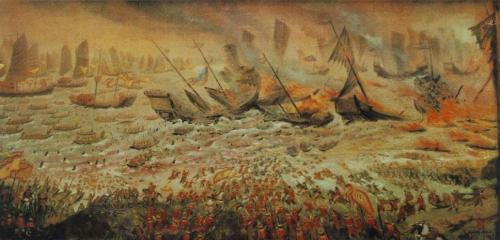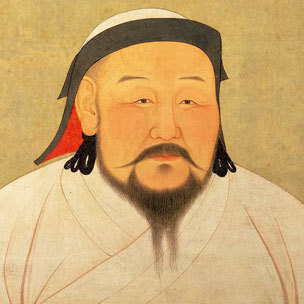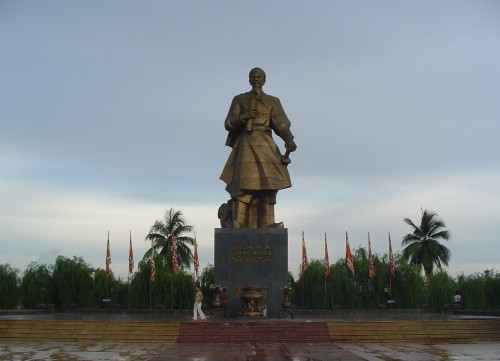peashooter85:Tran Hung Dao and the failed Mongol invasions of Vietnam.In the 1960’s the United State
peashooter85:Tran Hung Dao and the failed Mongol invasions of Vietnam.In the 1960’s the United States became bogged down in fierce guerrilla warfare, jungle fighting, political turmoil, and bad military policy. For the first time in the 20th century, the mighty US military had been halted in its tracks by an army of peasant fighters with inferior supplies, training, and weaponry. The legacy of Vietnam today is a legacy of tragedy and failure, a dark chapter in American history that still affects the American psyche today. However the Vietnam War was not the first time the people of Vietnam would stand against a major superpower. Over 700 years before the Vietnam War the Vietnamese successfully repelled not one but three invasions by the great superpower of the day; the mighty Mongol Empire. By the 13th Century the Mongols had built one of the largest and most powerful empires in world history, ruling over a realm that spanned over Russia, China, the Middle East, and Eastern Europe. The Mongol Army was the best in the world, a perfect combination of discipline, lightning tactics, toughness, and ruthlessness. In 1260 Kublai Khan, grandson of the famous Genghis Kahn, ascended to the throne as Great Kahn of the Mongol Empire and proceeded to continue the Mongol conquests. In the sights of the Great Kahn was a small kingdom to the south called Đại Việt (Vietnam).The Kingdom of Dai Viet was well accustomed to invasion from the north, over hundreds of years the Chinese had harassed the small kingdom in an attempt to absorb the small country into their own empire. By the time Kublai Khan gained power the Mongols had already attempted an invasion of Dai Viet under the leadership of Mongke Kahn. Kublai Kahn was determined more than ever to conquer the small kingdom. Kublai raised a large army to conquer the kingdom of Champa (South Vietnam) and demanded Dai Viet permit passage through their kingdom. The Vietnamese refused. Unbothered by this, Kublai ordered his 100,000 man army to invade Dai Viet, a mistake he would soon regret. At first the Mongolian Army would see great successes, even conquering the Vietnamese capitol of Thăng Long (Hanoi). When it seemed that all was lost, the Vietnamese turned to a great general named Trần Hưng Đạo to repel the invaders. Knowing that he could not fight muzzle to muzzle against the mighty Mongol Army with a force of untrained, poorly equipped peasants, Tran Hung Dao devised a campaign of guerrilla warfare to slowly weaken and destroy the Mongols. First he evacuated the north, burning all villages and crops so they would not fall into enemy hands. Whenever the Mongols advanced they conquered nothing but ashes and ruin. This was devastating as the Mongol Army depended on foraging and pillaging of food for survival. Secondly Tran devised a series of tactics that negated the power of Mongol cavalry. The backbone and strength of the Mongol Army remained with its cavalry forces. Born to nomadic tribes in the Gobi Desert, Mongols were said to learn to ride a horse before they could even walk. As a result Mongol horsemen are among the greatest cavalrymen in history. However the tropical landscape was nothing like the Gobi Desert, Middle East, Europe, or the Steppes, places where the Mongol cavalry had experienced great victories in the past. With rolling hills covered in dense jungle, Vietnam was a horseman’s nightmare. Tran’s army lived in the jungle and attacked from the jungle, breaking down the Mongol Army a piece at a time with hit and run tactics and surprise attacks from all directions. The Mongols, accustomed to fighting in open plains, could do little to fend off the attacks or strike a blow against Tran’s army. One of the most common tactics used by the Vietnamese was to draw Mongol cavalry into a thick swamp. When the Mongol warriors became trapped in waist deep mud the Vietnamese jungle fighters would strike, impaling the helpless Mongols with bamboo stakes. Tran and his army also mastered the art of booby traps, setting up complex traps across trails and highways all over the country. One common trap was the pitfall with punji sticks. A small pit was dug around two to three feet deep. Lined inside the pit were sharpened stakes made of wood or bamboo which were sometimes covered in poison or feces (to cause infection). The pit was then covered over and camouflaged to avoid the notice of enemy soldiers. When a soldier stepped on the pit, his foot would fall through becoming impaled on the sharpened stakes. Often the stakes were barbed or pointed in a downward angle or, making it impossible for the wounded soldier to remove his leg without causing terrible injury. 700 years later the same tactic became a staple of Vietcong Guerrillas against the Americans during the Vietnam War.Eventually the mighty Mongol Army found itself trapped in the middle of Vietnam short of food and supplies, hampered by mud and dense jungle, and being nibbled to death by the guerrilla attacks of the Vietnamese. Worse yet the army began to feel the effects of tropical diseases such as malaria, yellow fever, and dysentery. By 1285 AD the “invincible” Mongol Army was forced to retreat after suffering terrible casualties. The defeat did not discourage Khublai Khan, however, who gathered an enormous force of 500,000 soldiers in 1287 to destroy Vietnam once and for all. This time Kublai Kahn created a new strategy, a two pronged attack designed to counter Tran Hung Dao’s scorched earth policy. Rather than rely on pillaging the countryside for food, Kublai Khan had a massive fleet of 500 ships built which were to supply the Mongol Army. The second campaign would go much like the first. The Mongol Army captured large areas to the north while Tran burned all crops and supplies to prevent them from falling into Mongol hands. This time, however, the Mongol Army received fresh supplies from China via its massive supply fleet. In 1288 Tran devised a brilliant plan to destroy the Mongol fleet and turn the tide of the war. Tran ordered beds of iron tipped stakes placed on the bottom of the Bạch Đằng River. With a small flotilla of boats the Vietnamese lured the Mongol fleet into the river. The fleet retreated from the river just as the tide went down, and most of the fleet’s ships were impaled and trapped on the stakes. Vietnamese archers fired on the ships from the shore with flaming arrows while small Vietnamese boats traveled ship to ship, setting each alight with flaming pitch or palm oil. Those who abandoned ship were quickly dispatched by Tran’s army as they scrambled to swim ashore. In one fell swoop the Mongol fleet was completely obliterated with a loss of over 80,000 men.Without the supply fleet, the massive 500,000 man army was in an even worse situation than the invasion before, with over five times the number of mouths to feed. The Mongol advance immediately halted as the army began to starve. Seeing the Mongol weakness, Tran Hung Dao ordered massive counterattacks, harassing the Mongol Army and making its position even more precarious. Eventually the Mongols were once again forced to withdraw with Vietnamese forces attacking it all the way back to China. The Mongols suffered casualties and losses the likes of which they had never experienced in the history of their conquests.The failed conquests of Vietnam, combined with the failed invasion of Japan and Java would humble the mighty Mongol Empire and mark the end of Mongol expansion. Tran Hung Dao would be celebrated as a national hero, with his memory revived after the North Vietnamese victory in the Vietnam War. He died on 1300 AD of natural causes, and was buried in a simple grave, refusing to be interned in a grand mausoleum or tomb. -- source link


